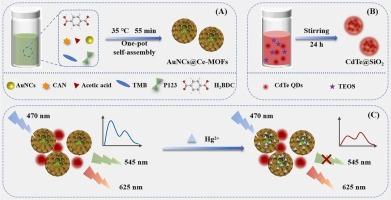AuNCs@Ce-MOFs/CdTe@SiO 2:用于检测Hg²+的新型比例荧光复合材料的制备和应用
IF 3.7
1区 化学
Q1 CHEMISTRY, ANALYTICAL
引用次数: 0
摘要
开发一种灵敏、准确的Hg2+检测方法,对保障水环境安全和保护人类健康至关重要。虽然基于金纳米簇(aunc)的荧光传感方法可以通过特定的Au-Hg识别来选择性地检测Hg2+,但由于aunc的发光效率低,单方法检测容易受到环境干扰,其灵敏度和准确性有待提高。本文通过一步原位自组装的方法,将AuNCs封装在具有大孔径和多孔结构的铈金属有机骨架(Ce-MOFs)的孔隙中,得到了具有优越发光性能和增强稳定性的AuNCs@Ce-MOFs复合材料。研究明确地表明,AuNCs@Ce-MOFs的显著发光特性主要归因于两个关键机制:一是由于AuNCs表面配体6-偶氮-2-硫腺嘧啶与ce - mof内的铈离子之间的配位而产生的分子内运动(RIM)效应的限制,二是AuNCs的本征聚集诱导发射(AIE)效应特性。在此基础上,结合二次荧光探针CdTe@SiO2(其中SiO2涂层抑制CdTe量子点(QDs)与AuNCs@Ce-MOFs之间的光致电子转移过程),开发了一种能灵敏、选择性、准确检测水中Hg2+的参比型比例荧光传感平台。本文章由计算机程序翻译,如有差异,请以英文原文为准。

AuNCs@Ce-MOFs/CdTe@SiO₂: Preparation and application of a novel ratiometric fluorescent composite for the detection of Hg²+
The development of a sensitive and accurate method for detecting Hg2+ is essential to ensuring the safety of the water environment and protecting human health. Although fluorescence sensing methods based on gold nanoclusters (AuNCs) can selectively detect Hg2+ via specific Au-Hg recognition, their sensitivity and accuracy require enhancement due to the low luminescence efficiency of AuNCs and the susceptibility of single-method detection to environmental interference. Herein, AuNCs were encapsulated within the pores of cerium metal-organic frameworks (Ce-MOFs) featuring a large pore size and porous architecture via a one-step in-situ self-assembly approach, yielding a AuNCs@Ce-MOFs composite that exhibited superior luminescence performances and enhanced stability. Studies have unequivocally demonstrated that the remarkable luminescence properties of AuNCs@Ce-MOFs are primarily ascribed to two pivotal mechanisms: the restriction of intramolecular motion (RIM) effect, which arises from the coordination between the AuNCs surface ligand 6-aza-2-thiothymine and the cerium ions within Ce-MOFs, and the intrinsic aggregation-induced emission (AIE) effect characteristic of AuNCs. On this basis, in conjunction with a secondary fluorescent probe, namely CdTe@SiO2, where the SiO2 coating serves to suppress the photoinduced electron transfer process between CdTe quantum dots (QDs) and AuNCs@Ce-MOFs, a reference-type ratiometric fluorescence sensing platform that enables sensitive, selective, and accurate detection of Hg2+ in water was developed.
求助全文
通过发布文献求助,成功后即可免费获取论文全文。
去求助
来源期刊

Sensors and Actuators B: Chemical
工程技术-电化学
CiteScore
14.60
自引率
11.90%
发文量
1776
审稿时长
3.2 months
期刊介绍:
Sensors & Actuators, B: Chemical is an international journal focused on the research and development of chemical transducers. It covers chemical sensors and biosensors, chemical actuators, and analytical microsystems. The journal is interdisciplinary, aiming to publish original works showcasing substantial advancements beyond the current state of the art in these fields, with practical applicability to solving meaningful analytical problems. Review articles are accepted by invitation from an Editor of the journal.
 求助内容:
求助内容: 应助结果提醒方式:
应助结果提醒方式:


